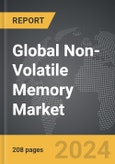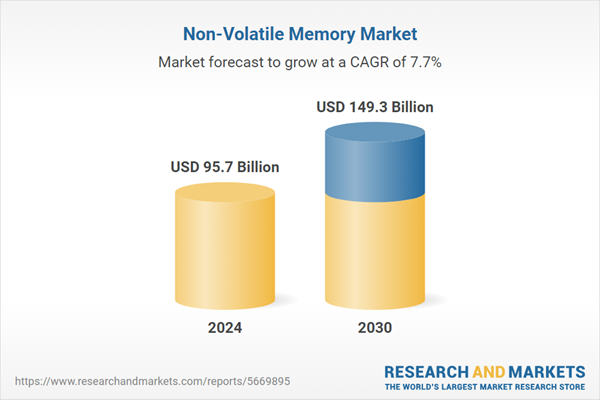The global market for Non-Volatile Memory was valued at USD 95.7 Billion in 2024 and is projected to reach USD 149.3 Billion by 2030, growing at a CAGR of 7.7% from 2024 to 2030. This comprehensive report provides an in-depth analysis of market trends, drivers, and forecasts, helping you make informed business decisions.
The importance of non-volatile memory lies in its ability to store data permanently, making it a crucial component in devices that require reliable storage over time. NVM enables everything from booting up operating systems to preserving user data across power cycles. As digital transformation accelerates and data storage needs grow, NVM is playing a key role in ensuring fast, secure, and efficient data access in modern computing systems.
Another important trend is the increasing integration of NVM in edge computing and IoT devices. As data processing shifts closer to the edge, where real-time data analysis and decision-making are required, NVM provides reliable, low-latency storage for these systems. The rise of autonomous vehicles, smart homes, and connected industrial systems is further boosting demand for high-performance NVM that can store and process large amounts of data efficiently.
The consumer electronics industry, particularly smartphones, tablets, and wearable devices, also relies heavily on NVM for storing user data, apps, and operating systems. Additionally, the rise of smart devices in homes, cities, and industries is driving adoption of NVM in IoT systems, where data persistence and low power consumption are critical for the performance and longevity of connected devices.
The expansion of the IoT and edge computing markets is also fueling demand for NVM, as these devices require low-latency, non-volatile storage to process and store data in real-time. Additionally, the increasing complexity of automotive systems, including the rise of autonomous vehicles and advanced infotainment, is boosting demand for high-reliability NVM that can store critical data securely and efficiently.
Global Non-Volatile Memory Market - Key Trends & Drivers Summarized
What Is Non-Volatile Memory and Why Is It Critical in Modern Computing?
Non-volatile memory (NVM) refers to a type of memory that retains stored data even after the power is turned off, unlike volatile memory (such as DRAM). Common types of NVM include flash memory, electrically erasable programmable read-only memory (EEPROM), and emerging technologies like resistive random-access memory (ReRAM) and phase-change memory (PCM). NVM is essential for long-term data storage in a wide range of applications, from consumer electronics like smartphones and laptops to enterprise data centers, automotive systems, and industrial equipment.The importance of non-volatile memory lies in its ability to store data permanently, making it a crucial component in devices that require reliable storage over time. NVM enables everything from booting up operating systems to preserving user data across power cycles. As digital transformation accelerates and data storage needs grow, NVM is playing a key role in ensuring fast, secure, and efficient data access in modern computing systems.
How Is the Non-Volatile Memory Market Evolving?
The non-volatile memory market is evolving due to the increasing demand for faster, more efficient storage solutions, particularly in data-heavy applications such as cloud computing, AI, and IoT. One of the key trends in the market is the development of next-generation NVM technologies, such as 3D NAND, ReRAM, and phase-change memory (PCM), which offer higher densities, faster read/write speeds, and lower power consumption compared to traditional NAND flash memory. These advanced memory solutions are gaining traction in data centers, automotive electronics, and consumer devices, as they can meet the growing performance and storage requirements of modern applications.Another important trend is the increasing integration of NVM in edge computing and IoT devices. As data processing shifts closer to the edge, where real-time data analysis and decision-making are required, NVM provides reliable, low-latency storage for these systems. The rise of autonomous vehicles, smart homes, and connected industrial systems is further boosting demand for high-performance NVM that can store and process large amounts of data efficiently.
Which Industries Are Leading the Adoption of Non-Volatile Memory?
The data storage and computing industries are the largest adopters of non-volatile memory, using NVM extensively in solid-state drives (SSDs) and other storage solutions. NVM is critical for enterprise data centers and cloud service providers, where large volumes of data must be stored securely and accessed quickly. The automotive industry is another major user of NVM, particularly in advanced driver-assistance systems (ADAS) and infotainment systems, where reliable, long-term data storage is crucial for vehicle safety and user experience.The consumer electronics industry, particularly smartphones, tablets, and wearable devices, also relies heavily on NVM for storing user data, apps, and operating systems. Additionally, the rise of smart devices in homes, cities, and industries is driving adoption of NVM in IoT systems, where data persistence and low power consumption are critical for the performance and longevity of connected devices.
What Are the Key Growth Drivers in the Non-Volatile Memory Market?
The growth in the non-volatile memory market is driven by the increasing demand for high-performance storage solutions in data centers, consumer electronics, and automotive systems. As data storage needs grow with the expansion of cloud computing, big data, and AI, the demand for faster, more efficient NVM solutions is rising. Another key driver is the ongoing development of next-generation NVM technologies, such as ReRAM, 3D NAND, and PCM, which offer improved performance, density, and power efficiency compared to traditional flash memory.The expansion of the IoT and edge computing markets is also fueling demand for NVM, as these devices require low-latency, non-volatile storage to process and store data in real-time. Additionally, the increasing complexity of automotive systems, including the rise of autonomous vehicles and advanced infotainment, is boosting demand for high-reliability NVM that can store critical data securely and efficiently.
Report Scope
The report analyzes the Non-Volatile Memory market, presented in terms of market value (USD Thousand). The analysis covers the key segments and geographic regions outlined below.Segments
End-Use (Consumer Electronics, Enterprise Storage, Automotive & Transportation, Military & Aerospace, Industrial, Telecommunications, Other End-Uses).Geographic Regions/Countries
World; United States; Canada; Japan; China; Europe (France; Germany; Italy; United Kingdom; and Rest of Europe); Asia-Pacific; Rest of World.Key Insights:
- Market Growth: Understand the significant growth trajectory of the Consumer Electronics End-Use segment, which is expected to reach $68.4 Billion by 2030 with a CAGR of a 8%. The Enterprise Storage End-Use segment is also set to grow at 8.4% CAGR over the analysis period.
- Regional Analysis: Gain insights into the U.S. market, valued at $26.7 Billion in 2024, and China, forecasted to grow at an impressive 7.2% CAGR to reach $22.9 Billion by 2030. Discover growth trends in other key regions, including Japan, Canada, Germany, and the Asia-Pacific.
Report Features:
- Comprehensive Market Data: Independent analysis of annual sales and market forecasts in USD from 2024 to 2030.
- In-Depth Regional Analysis: Detailed insights into key markets, including the U.S., China, Japan, Canada, Europe, Asia-Pacific, Latin America, Middle East, and Africa.
- Company Profiles: Coverage of major players such as Adesto Technologies Corporation, Crossbar Inc., Everspin Technologies Inc., Fujitsu Ltd., Intel Corporation and more.
- Complimentary Updates: Receive free report updates for one year to keep you informed of the latest market developments.
Why You Should Buy This Report:
- Detailed Market Analysis: Access a thorough analysis of the Global Non-Volatile Memory Market, covering all major geographic regions and market segments.
- Competitive Insights: Get an overview of the competitive landscape, including the market presence of major players across different geographies.
- Future Trends and Drivers: Understand the key trends and drivers shaping the future of the Global Non-Volatile Memory Market.
- Actionable Insights: Benefit from actionable insights that can help you identify new revenue opportunities and make strategic business decisions.
Key Questions Answered:
- How is the Global Non-Volatile Memory Market expected to evolve by 2030?
- What are the main drivers and restraints affecting the market?
- Which market segments will grow the most over the forecast period?
- How will market shares for different regions and segments change by 2030?
- Who are the leading players in the market, and what are their prospects?
Some of the 12 major companies featured in this Non-Volatile Memory market report include:
- Adesto Technologies Corporation
- Crossbar Inc.
- Everspin Technologies Inc.
- Fujitsu Ltd.
- Intel Corporation
- Microchip Technology, Inc.
- Micron Technology, Inc.
- Nantero, Inc.
- Samsung Electronics Co., Ltd.
- SK Hynix, Inc.
- Toshiba Corporation
- Viking Technologes
- Western Digital Corporation
Table of Contents
I. METHODOLOGYII. EXECUTIVE SUMMARY2. FOCUS ON SELECT PLAYERSIII. MARKET ANALYSISIV. COMPETITION
1. MARKET OVERVIEW
3. MARKET TRENDS & DRIVERS
4. GLOBAL MARKET PERSPECTIVE
UNITED STATES
CANADA
JAPAN
CHINA
EUROPE
FRANCE
GERMANY
ITALY
UNITED KINGDOM
REST OF EUROPE
ASIA-PACIFIC
REST OF WORLD
Companies Mentioned (Partial List)
A selection of companies mentioned in this report includes, but is not limited to:
- Adesto Technologies Corporation
- Crossbar Inc.
- Everspin Technologies Inc.
- Fujitsu Ltd.
- Intel Corporation
- Microchip Technology, Inc.
- Micron Technology, Inc.
- Nantero, Inc.
- Samsung Electronics Co., Ltd.
- SK Hynix, Inc.
- Toshiba Corporation
- Viking Technologes
- Western Digital Corporation
Table Information
| Report Attribute | Details |
|---|---|
| No. of Pages | 208 |
| Published | April 2025 |
| Forecast Period | 2024 - 2030 |
| Estimated Market Value ( USD | $ 95.7 Billion |
| Forecasted Market Value ( USD | $ 149.3 Billion |
| Compound Annual Growth Rate | 7.7% |
| Regions Covered | Global |









